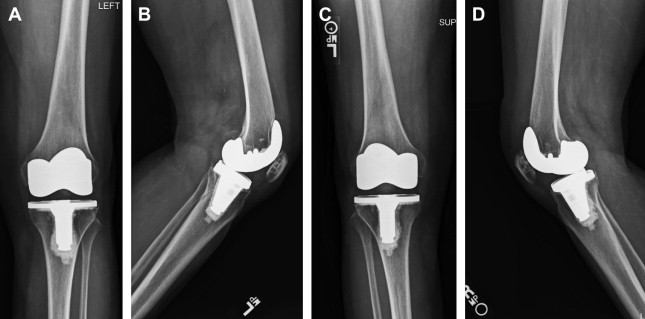This article presents the clinical features of crystal arthropathy after knee replacement. The current literature on pseudogout and gout after both total and partial knee replacement is summarized. A case of bilateral pseudogout 8 years after initial total knee arthroplasty (TKA) is used to highlight the clinical characteristics and treatment options for this underrecognized condition. Presentation mimicked a late septic joint arthroplasty with sudden onset of pain and effusion. The patient was treated successfully with an arthrotomy, debridement, synovectomy, polyethylene insert exchange, oral steroids, and nonsteroidal anti-inflammatories. There are no other reported cases of bilateral pseudogout after bilateral TKA.
- •
Pseudogout and gout should be considered in the differential diagnosis of patients with acute pain after joint replacement.
- •
Infection and crystal arthropathy have very similar presentations after joint replacement and can often be confused for one another.
- •
A full infectious workup should be initiated in all patients with pain after arthroplasty even if crystal arthropathy is suspected.
- •
There are no large studies describing crystal arthropathy; however, the current literature available suggests that it is a true entity and can be treated well with a combination of medical and surgical management.
- •
The true prevalence of crystal arthropathy after joint replacement is still unknown.
Introduction
Acute onset of pain and swelling after a total knee arthroplasty (TKA) should prompt an immediate and thorough workup to rule out infection. Despite the importance of excluding infection, one must also consider the uncommon diagnosis of crystal arthropathy. Although rare, gout and pseudogout have similar presentations in the infected TKA and may mimic a prosthetic joint infection. Symptoms may include erythema, warmth, pain, and decreased range of motion, as well as constitutional symptoms such as fever and malaise. Both gout and pseudogout may be clinically indistinguishable from septic arthritis on physical examination as well as laboratory examination.
To date, the literature contains only a few published reports of unilateral gout or pseudogout after TKA. To the authors’ knowledge, this is the first published case of bilateral pseudogout after bilateral TKA.
Case report
The patient was a 70-year-old woman 8 years after bilateral TKA, with acute onset of bilateral knee pain for 1 day. The patient had been very happy and pain free with her total knees for the past 8 years, without any complaints. She had been walking without assistance and was exercising daily. The morning before presentation she woke up with severe bilateral knee pain and could not stand. The patient presented in a wheelchair and reported severe pain and inability to ambulate because of the pain. She had no recent history of infection and no prior constitutional complaints.
On examination on the day of presentation, the knees were erythematous with a moderate effusion. She had severe pain with limited range of motion; the range of motion was 30° to 90° bilaterally. Both knees were aspirated under sterile conditions and the aspirate was suspicious for infection. A thick, brownish, viscous fluid was aspirated from both knees. The white blood cell (WBC) count in the joint fluid aspirate of both knees was 64,200×10 9 /L and 89,500×10 9 /L, with 76% and 82% neutrophils. This aspirate did not initially demonstrate crystals on microscopic evaluation. The erythrocyte sedimentation rate (ESR) was 25mm/h and the C-reactive protein (CRP) was elevated at 13.4mg/L. The patient also had an elevated serum WBC of 12.3×10 9 /L. Radiographs demonstrated well-aligned bilateral TKAs without any sign of loosening or osteolysis ( Fig. 1 ).






